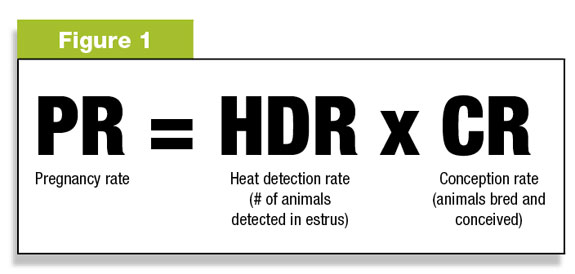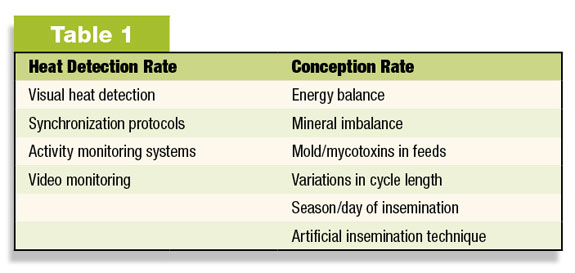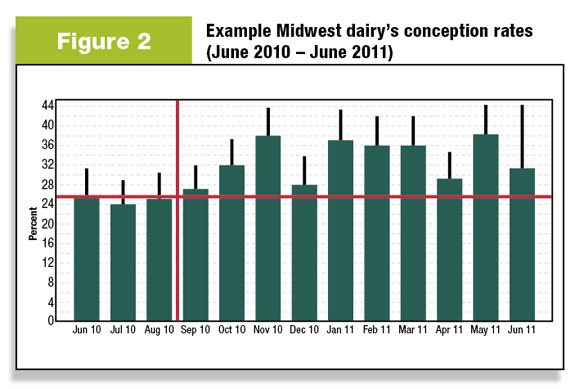Over time the knowledge and ability to get cows bred has taken tremendous strides towards greater on-farm success. Reproductive success takes effort from every angle of the dairy and starts with an understanding of pregnancy rate and the factors which impact it most.
Untangling the equation
In the past, pregnancy rate has been evaluated by looking at the percentage of cows bred during a 21-day heat cycle and confirmed pregnant. Rather than looking at the equation in three-week increments, dairy producers can learn more about herd pregnancy rate by further investigating what is included in the following equation (See Figure 1 .)

Evaluating pregnancy rate by focusing on heat detection rate and conception rate separately can allow you to better evaluate where change can be implemented to see improvements.
Table 1 outlines some of the influencers on heat detection rate and conception rate.
Reproductive technology advancements have helped dairies improve the precision of heat detection rate more significantly in the past few years, and changes can be seen in as quickly as two to three estrous cycles.

Conception rate is much more confounded because it is impacted by many areas of the dairy operation and variables that are hard to control. Improving conception rate requires a commitment and investment from the dairy producer.
Boosting conception rate with the ration
One area that can have a profound effect on the cow’s ability to conceive is nutrition. Many key parts of the ration – like energy levels – will directly impact the dairy cow’s ability to become pregnant.
After all, reproduction is a luxury that can only be achieved when the proper ration and environment fulfills maintenance and milk production requirements.

Within a properly balanced diet, specific supplements can help improve conception rates and reproductive success. One tool nutritionists have identified is omega-3 and omega-6 essential fatty acids (EFAs). EFAs aid in several significant biological functions. (See Table 2 .)
On-farm research confirms the benefits of a ration supplemented with bypass omega-3 and omega-6 EFAs. In the trial, cows fed bypass EFAs had higher pregnancy rates by five percentage points. Since heat detection was similar between the two groups, the improved pregnancy rate was achieved through an enhanced conception rate.
Adding EFAs to the dairy cow’s ration has additional benefits that can impact the reproductive success of your herd. Omega-3 and omega-6 EFAs can optimize immune function, enhance visible signs of heat and reduce incidence of metabolic disorders postpartum.
The pregnancy rate in summary
An optimal pregnancy rate and reproductive success takes efforts from all areas of the dairy. Work with those involved on your operation and your herd nutritionist to identify opportunities for improvements, keeping in mind:
- Pregnancy rate is the product of both heat detection rate and conception rate.
- Reproductive advancements allow for heat detection rate to improve more simplistically, whereas conception rate is impacted by a variety of variables.
- Conception rate is confounded by multiple factors and is a long-term investment.
- Dairies should isolate conception rate and heat detection rate to fully understand where change can be most impactful.
Examine conception rate independently
Each day dairy producers evaluate and analyze herd reproduction to see where gains can be made. Untangling the pregnancy rate equation can help you better understand where change is taking place.

A 1,100-cow Midwest dairy feeding a ration supplemented with bypass omega-3 and omega-6 EFAs has increased herd pregnancy rates.
However, the dairy decided to investigate if the nutritional change was really the variable making the difference or if other factors – like heat detection – improved herd performance.
Utilizing records from DairyComp 305, the dairy was able to isolate conception rate and see if the ration caused the overall increase in pregnancy rate. Based on the findings, the dairy left their ration unchanged to maintain conception rate gains.
Figure 2 , pulled from the Midwest dairy herd’s DairyComp 305 records, illustrates the consistent increase in conception rates beginning in September 2010, following ration changes in August. The horizontal line in Figure 2 represents the average herd conception rate prior to the ration formulation change. PD
Pankowski has more than two decades of technical on-farm support experience and currently consults with nutritionists and dairy producers in the Northeast and Midwest.
References omitted due to space but are available upon request to editor@progressivedairy.com .

-
Joel Pankowski
- Field Technical Services
- Arm & Hammer Animal Nutrition
- Email Joel Pankowski






